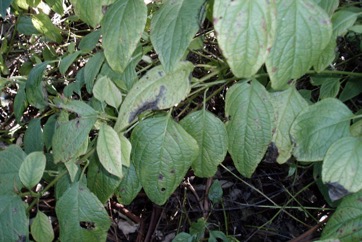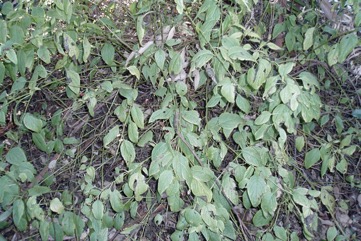Shrubby deeringia

A tropical plant. It occurs in the Sepik, Madang, Morobe and Central Provinces in Papua New Guinea. It is often near forest edges near creeks in the rainforest. It occurs up to 1200 m altitude. This plant is also used as food in Fiji, Indonesia and Taiwan. It needs a well drained humus rich soil. It needs a sheltered position and partial shade. It is drought and frost tender.
Also known as:
Bajam besar, Bajam pohon, Bakri sag, Bayam besar, Bayem luur, Chhorachhuri saag, Dalbergia karat, Dialinh den, Ditiran, Gaulmauni, Gola-mohani, Handing, Hanthai, Janger, Kakum, Kala-loari, Khruea yang, Kyet-sa-gwe, Latman, Mathak thuka, Mborowa, Men meni, Monbir, Onno ligbo reibe, Parongbee, Peh-zerak, Phaahom plaa, Rangoli lota, Rangoli-lota, Sili-silihan, Tokoi
Synonyms
- Achyranthes amaranthoides Lam.
- Celosia baccata Retz.
- Cladostachys frutescens D. Don.
- Cladostachys amaranthoides (Lam.) K. C. Kuan
- Deeringia celosioides R Brown
- Deeringia baccata (Retz.) Moq.
Edible Portion
- Leaves, Seeds
Where does Shrubby deeringia grow?
Found in: Africa, Asia, Australia, Bhutan, China, Christmas Island, East Timor, Fiji, Himalayas, India, Indochina, Indonesia, Laos, Malaysia, Micronesia, Myanmar, Nepal, Northeastern India, Pacific, Pakistan, Papua New Guinea, PNG, Philippines, Sao Tome and Principe, Saipan, SE Asia, Sikkim, Slovenia, Solomon Islands, Taiwan, Thailand, Timor-Leste, Vietnam
Notes: There are about 6-12 Deeringia species.
Status: It is a cultivated plant.
Growing Shrubby deeringia
Cultivation: It grows wild. Plants are grown from seed. The seed need to be sown fresh. Plants can also be easily grown from cuttings.
Edible Uses: The young leaves are cooked and eaten as a vegetable. CAUTION This plant is suspected of poisoning cattle. (Often cattle forget to cook their food!!) The young leaves can be stored for 3-4 days.
Nutrition Info
per 100g edible portion| Edible Part | Energy (kcal) | Protein (g) | Iron (mg) | Vitamin A (ug) | Vitamin c (mg) | Zinc (mg) | % Water |
|---|---|---|---|---|---|---|---|
| - | - | - | - | - | - |
Shrubby deeringia Photos


References
Ambasta, S.P. (Ed.), 2000, The Useful Plants of India. CSIR India. p 165
Bao Bojian; Steve Clemants, Thomas Borsch, Amaranthaceae [Draft], Flora of China
Bodkin, F., 1991, Encyclopedia Botanica. Cornstalk publishing, p 330
Borrell, O.W., 1989, An Annotated Checklist of the Flora of Kairiru Island, New Guinea. Marcellin College, Victoria Australia. p 48
Burkill, I.H., 1966, A Dictionary of the Economic Products of the Malay Peninsula. Ministry of Agriculture and Cooperatives, Kuala Lumpur, Malaysia. Vol 1 (A-H) p 787
Chowdery, T., et al, 2014, Wild edible plants of Uttar Dinajpur District, West Bengal. Life Science Leaflets. 47:pp 20-36 http://lifesciencesleaflets.ning.com
Cooper, W. and Cooper, W., 2004, Fruits of the Australian Tropical Rainforest. Nokomis Editions, Victoria, Australia. p 14
Dangol, D. R. et al, 2017, Wild Edible Plants in Nepal. Proceedings of 2nd National Workshop on CUAOGR, 2017.
Dutta, U., 2012, Wild Vegetables collected by the local communities from the Churang reserve of BTD, Assam. International Journal of Science and Advanced Technology. Vol. 2(4) p 121
Elliot, W.R., & Jones, D.L., 1984, Encyclopedia of Australian Plants suitable for cultivation. Vol 3. Lothian. p 215
Franklin, J., Keppel, G., & Whistler, W., 2008, The vegetation and flora of Lakeba, Nayau and Aiwa Islands, Central Lau Group, Fiji. Micronesica 40(1/2): 169–225, 2008
French, B.R., 1986, Food Plants of Papua New Guinea, A Compendium. Asia Pacific Science Foundation p 341
French, B.R., 2010, Food Plants of Solomon Islands. A Compendium. Food Plants International Inc. p 318
Ghosh, C. & Das A. P., 2011, Some useful and poisonous tea garden weeds from the Darjiling District of West Bengal, India. Pleione 5(1): 91 - 114
Henty, E.E., 1980, Harmful Plants in Papua New Guinea. Botany Bulletin No 12. Division Botany, Lae, Papua New Guinea. p 8, Pl. 1
Heywood, V.H., Brummitt, R.K., Culham, A., and Seberg, O. 2007, Flowering Plant Families of the World. Royal Botanical Gardens, Kew. p 29
Interpr. Herb. amboin. 211. 1917
Jones, D.L. & Gray, B., 1977, Australian Climbing Plants. Reed. p 95
Joshi, N., et al, 2007, Traditional neglected vegetables of Nepal: Their sustainable utilization for meeting human needs. Tropentag 2007. Conference on International Agricultural Research for Development.
Kanis, A in Womersley, J.S., (Ed), 1978, Handbooks of the Flora of Papua New Guinea. Melbourne University Press. Vol 1. p 32
Kar, A., & Borthakur, S. K., 2008, Wild vegetables of Karbi - Anglong district, Assam, Natural Product Radiance, Vol. 7(5), pp 448-460
Leach, G. J., 1988, Bush Food Plants of the Blackwater and Karawari Rivers Area, East Sepik Province, Papua New Guinea. Science in New Guinea 14(2). p 101
Martin, F.W. & Ruberte, R.M., 1979, Edible Leaves of the Tropics. Antillian College Press, Mayaguez, Puerto Rico. p 174
Ochse, J.J. et al, 1931, Vegetables of the Dutch East Indies. Asher reprint. p 30
Paczkowska, G. & Chapman, A.R., 2000, The Western Australian Flora. A Descriptive Catalogue. Western Australian Herbarium. p 137
Patiri, B. & Borah, A., 2007, Wild Edible Plants of Assam. Geethaki Publishers. p 110
Pham-Hoang Ho, 1999, An Illustrated Flora of Vietnam. Nha Xuat Ban Tre. p 726
Priyadi, H., et al, Five hundred plant species in Gunung Halimun Salak National Park West Java. A checklist including Sundanese names, distribution and use. CIFOR, FFPRI, SLU p 137
Sakar, A. & Das, A. P., 2018, The traditional knowledge on edible wild leafy vegetables of Rabha Tribe in Duars of North Bengal: a potential reinforcement to food security. Pleione 12(2): 275 - 281. 2018.
Sarma, H., et al, 2010, Updated Estimates of Wild Edible and Threatened Plants of Assam: A Meta-analysis. International Journal of Botany 6(4): 414-423
Savita, et al, 2006, Studies on wild edible plants of ethnic people in east Sikkim. Asian J. of Bio Sci. (2006) Vol. 1 No. 2 : 117-125 ( As Deeringia celosioides)
Smith, A.C., 1981, Flora Vitiensis Nova: A New flora of Fiji, Hawai Botanical Gardens, USA Vol 2 p 283
Sukarya, D. G., (Ed.) 2013, 3,500 Plant Species of the Botanic Gardens of Indonesia. LIPI p 917
Wheeler, J.R.(ed.), 1992, Flora of the Kimberley Region. CALM, Western Australian Herbarium, p 112
Williams, K.A.W., 1999, Native Plants of Queensland Volume 4. Keith A.W. Williams North Ipswich, Australia. p 142
World Checklist of Useful Plant Species 2020. Royal Botanic Gardens, Kew